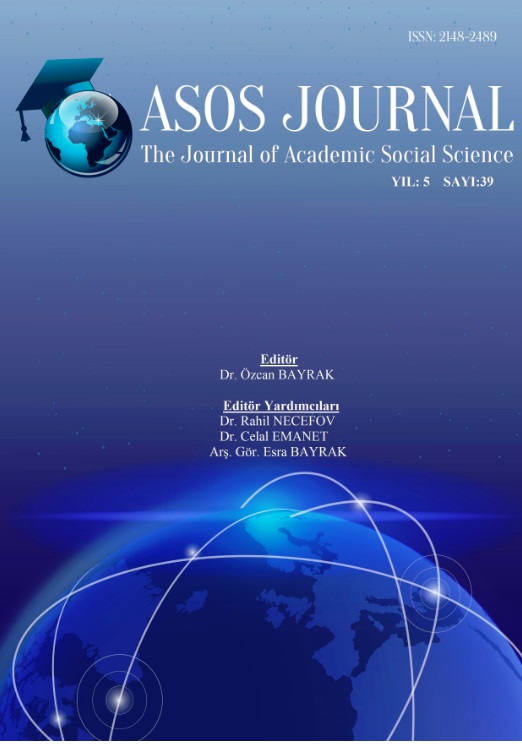DIE NEUE ORDNUNG (NIZAM-I CEDID) DES SULTANS SELIMS III. III. SULTAN SELİM’İN YENİ DÜZENİ (NİZAM-I CEDİD
Author :
Abstract
Osmanlı Devleti; aşiretten beyliğe beylikten devlete devletten imparatorluğa dönüşürken sürekli ilerleme ve gelişme kaydederek çok güçlü bir devlet teşkilatı oluşturmayı başarmıştır. Fakat XVIII. yüzyıl sonlarında zamanla ortaya çıkan bir takım iç ve dış meselelerden dolayı devlet gücünü kaybetmeye başlamış ve akabinde ise çöküş sürecine girmiştir. 28 Mart 1789 yılında Osmanlı tahtına çıkan Sultan III. Mustafa’nın (1757-1774) oğlu olan Sultan III. Selim (1789-1807), Osmanlı Devleti’nin içerisinde bulunduğu sorunları gidermek ve devletin yeniden eski gücüne kavuşabilmesi amacıyla bir takım ıslahat çalışmalarına başlamak istemiştir. Bunun üzerine III. Selim döneminin önemli devlet adamlarından olan Ebubekir Ratıp Efendi’yi Viyana elçiliği görevi ile üç yıllığına 1791 yılında Avrupa’ya göndererek oradaki askeri, idari ve mali teşkilatları hakkında bilgi toplamasını istemiştir. Bu bilgiler ışığında III. Selim ülkenin yönetimi ile ilgili her alanda yenileşmenin gerekliliğine inanmış bir kişi olarak Nizam-i Cedid adı altında Osmanlı Devleti’nin öncelikle askeri, idari, sosyal, eğitim, ekonomik ve diplomatik sahalarda birçok köklü yenilikler yapmaya sürüklemiştir. III. Selim halkı için yapmış olduğu bu yenilikler her ne kadar Osmanlı Devleti’nde bir iyileştirme gösterse de, idari ve sosyal alanlarda varlığını sürdüren bozuklukların tamamen ortadan kaldırılması mümkün olmamıştır. Girişilen bu yenilikler adı altındaki hareketler için kurulan İrad-i Cedid hazinesi için halktan toplanılan yeni vergiler halkı ekonomik sıkıntılara girdirmiştir. Bu ekonomik sıkıntılara daha fazla rıza göstermen halk tepkilerini göstererek yapılan bu yenilikleri istemediklerini belirtmişlerdir. III. Selim kendi halkından bile destek bulamayınca Mayıs 1807 yılında tahttan çekilmek zorunda bırakılmış ve daha sonra öldürülmüştür. İşte bu çalışmada; dönemin birinci ve ikinci el kaynakları ışığında Sultan III. Selim’in Avrupa standartlarında yapmak istediği yenilikleri hangi alanda gerçekleştirdiğine dair alanlar tespit edilmeye çalışılmıştır.
Keywords
Abstract
Ottoman Empire achieved a strong state organisation by making a continous progress while it was turning from a tribe to a principality, a principality to a state, and a state to an Empire. However, the Empire began losing its state power due to some internal and external issues that arose at the end of the 18th century and then it entered into a collapse period. Ascending the throne on 28 March 1780, Sultan Selim III (1789-1807) who was the son of the Sultan Mustafa III (1857-1774) encouraged some reforms in order to remove troubles from the Ottoman Empire and to enable the Empire to regain its previous strength. In connection, Selim III sent Ebubekir Ratıp Efendi, who was one of the most important statesmen of his reign to Europe in 1791 by assigning him to Vienna Embassy Selim III also ordered him to gather information about military, administrative and financial organisations there. In the light of this information, Selim III, who believed that Ottoman Empire must be renewed in every field about governmental issues supported radical innovations in military, administrative, social, economic, educational, diplomatic fields. In doing so, Selim III attached first to the importance of the military issues and established a modernised Ottoman army under the name of Nizam-i Cedid. Although the Ottoman Empire made a progress in above mentioned reforms that were realized for the Ottoman society in every field, troubles in administrative and social fields could not be completely resolved. New taxes collected from the public for Irad-i Cedid treasury which was established to meet expenses of the army caused economical problems among the society. Affected from these economical problems, the public reacted to the reformations and did not support them. As Sultan III was not welcomed by his own society about these reforms, he had to abdicate the throne on May, 1807 and later he was assasinated. In this study, we tried to detect in which fields these reformations were realized that were actually intended by Sultan Selim III to be able to catch European standards.





